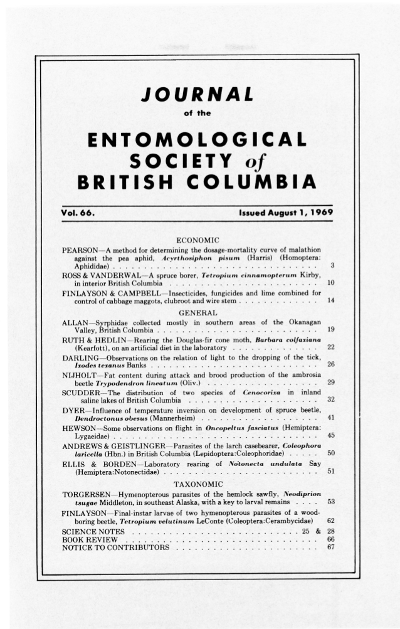Influence of temperature inversion on development of spruce beetle, <i>Dendroctonus obesus</i> (Mannerheim) (Coleoptera: Scolytidae)
Keywords:
spruce beetle, <i>Dendroctonus obesus</i>, Coleoptera, ScolytidaeAbstract
In the East Kootenay region of British Columbia, spruce logs infested by <i>Dendroctonus obesus</i> (Mannerheim) were placed beside thermographs at three sites. Throughout the summer, the mean and minimum air temperatures were higher on a mountain slope than in two valley bottoms at similar or lower elevations. Beetle development was faster on the mountain slope, where it continued until frost occurred in October, at which time 96% of the progeny were mature. In the lower valley bottom the minimum temperature fell 3.9 and 2.8∞C (7 and 5∞F.) below freezing on successive nights in August and larval development stopped. In the valley bottoms only 13 and 9% of the broods matured before winter. Temperature conditions that allow most broods of <i>D. obesus</i> to mature in one season may result in a critical addition to the normal number of beetles that mature after 2 years' development.References
Hayes, C.L. 1941. Influence of altitude and aspect on daily variations in factors of forest-fire danger. U.S. Dept. Agr. Circ. 591. 38 pp.
Knight, F.B. 1961. Variations in the life history of the Engelmann spruce beetle. Ann. Ent. Soc. Amer. 54:209-214.
Massey, C.L. and N.D. Wygant. 1954. Biology and control of the Engelmann spruce beetle in Colorado. U.S. Dept. Agric. Circ. 944. 35 pp.
Swaine, J.M. 1924. The control of the destructive spruce bark beetle in eastern Canada. Can. Dept. Agric. Pam. 48 (n.s.). 31 pp.
Watson, E.B. 1928. The bionomics of the spruce beetle Dendroctonus piceaperda Hopk. Scientific Agr. 3:613-635.
Woods, S.L. 1963. A revision of the bark beetle genus Dendroctonus Erichson (Coleoptera: Scolytidae). Great Basin Naturalist 23:1-117.
Downloads
Published
Issue
Section
License
Authors who publish with the Journal of the Entomological Society of British Columbia agree to the following terms:
-Authors retain copyright and grant the journal right of first publication with the work simultaneously licensed under a Creative Commons Attribution License that allows others to share the work with an acknowledgement of the work's authorship and initial publication in this journal.
-Authors are able to enter into separate, additional contractual arrangements for the non-exclusive distribution of the journal's published version of the work (e.g., post it to an institutional repository or publish it in a book), with an acknowledgement of its initial publication in this journal.
-Authors are permitted and encouraged to post their work online (e.g., in institutional repositories or on their website) prior to and during the submission process, as it can lead to productive exchanges, as well as earlier and greater citation of published work (See The Effect of Open Access).


